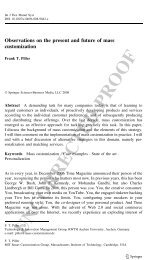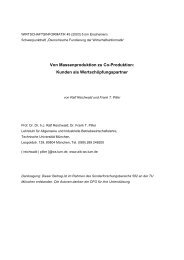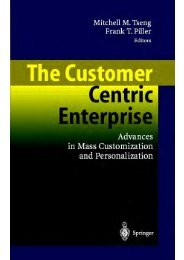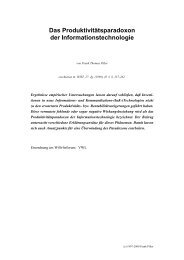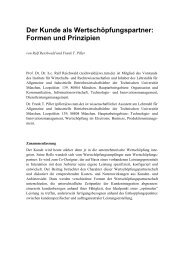Reichwald, Ralf / Piller, Frank
Reichwald, Ralf / Piller, Frank
Reichwald, Ralf / Piller, Frank
Sie wollen auch ein ePaper? Erhöhen Sie die Reichweite Ihrer Titel.
YUMPU macht aus Druck-PDFs automatisch weboptimierte ePaper, die Google liebt.
Kasten 3–8: Motives and Tools of Do-It-Yourself Inventors<br />
Die Kundenperspektive: Beteiligung an Open Innovation<br />
(Quelle: Auszug aus dem Beitrag “The amazing rise of the do-it-yourself economy” von Daniel<br />
Roth in der Zeitschrift Fortune (Europe), Nr. 9 / 2005 vom 30. Mai 2005: 24-35)<br />
(...) Pat Misterovich is just producing the next great MP3 music player. Only instead of the simple,<br />
elegant lines of the iPod, Misterovich’s device will look just like a Pez dispenser. Oh, and instead<br />
of working from a corporate campus in Cupertino, Calif., with nearly 12,000 employees,<br />
Misterovich is a stay-at-home dad, creating his Pez MP3 player from the basement of his<br />
Springfield, Mo., home.<br />
Misterovich is the former head of IT at the University of Detroit Mercy. He has few of the engineering<br />
skills necessary to build a device like this, no marketing experience, and absolutely no corporate<br />
infrastructure. And yet he’s got two factories—one in China, one in the U.S.-vying to build the<br />
player. He has a small Austin company started by an ex-Apple engineer designing the innards. And<br />
on his blog, pezmp3.com, he uses prospective buyers - some 1,500 people have already expressed<br />
interest—as an R&D-center-meets-focus-group. What’s better, he asks, AAA batteries or Li-<br />
Ion? In come dozens of replies (“Go for the AAA with a USB NiMh recharger if possible,” suggests<br />
one reader). What’s a good slogan? Some 50 ideas roll in (one of the best: “Candy for your ears”).<br />
By the end of this month the first prototype should be in Misterovich’s hands. “I don’t know that this<br />
product could have come to life years ago,” he says. “I seriously doubt it. And if it did, it wouldn’t<br />
have come through a guy in his basement.”<br />
It used to be that a tinkerer like Misterovich could, at best, hope to sell his idea to a big company.<br />
More likely, he’d entertain friends with his Pez-sized visions. But a number of factors are coming<br />
together to empower amateurs in a way never before possible, blurring the lines between those<br />
who make and those who take. Unlike the dot-com fortune hunters of the late 1990s, these do-ityourselfers<br />
aren’t deluding themselves with oversized visions of what they might achieve. Instead,<br />
they’re simply finding a way – in this mass-produced, Wal-Mart world – to take power back, prove<br />
that they can make the products that they want to consume, have fun doing so, and, just maybe,<br />
make a few dollars. “What’s happened is a tremendous change in awareness,” says Eric von<br />
Hippel, a professor at the MIT Sloan School of Management and author of the recent<br />
Democratizing Innovation. “Conventional wisdom is so strong [in business] about find-a-need-andfill-it:<br />
‘We’re the manufacturers; we design products; we ask users what they need; we do it.’ That<br />
has begun to crack.”<br />
(...) “Before, only the rich had access to tools and so only the rich were professionals, and the rest<br />
were amateurs,” says Noah Glass, the co-founder of Odeo, which offers a free service for making,<br />
hosting, and distributing podcasts. “But now, as the creation tools have become easier to use and<br />
more freely distributed through open source, through the Internet, through awareness, more people<br />
have more access to more tools, so the whole amateur-professional dichotomy is dissolving.”<br />
Citizen engineers are taking this even further, trying their hand not just in the digital world but in<br />
the physical world too. Much as eBay transformed distribution, they’re redefining design and manufacture.<br />
The infrastructure is there: Yahoo Groups make it easier for people to trade ideas and<br />
learn quickly; free or cheap computer-aided-design (CAD) programs allow users to cobble together<br />
blueprints; and inexpensive manufacturing in China allows the idea to go from file to factory.<br />
There are even websites like Alibaba.com that will help these small-timers find Chinese factories<br />
eager for their work, meaning that the amateur nation has its own Match.com.<br />
This may seem like a lot of effort to, say, create a funny-looking MP3 player. But that’s not this<br />
group’s ethos. “DIYers do things for irrational reasons,” says Saul Griffith. “If it’s your passion and<br />
your love, you don’t count how many hours you spend doing it. That’s why so many of these things<br />
end up being great.”<br />
141<br />
3.3




